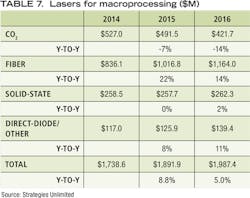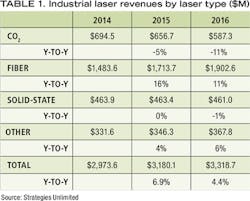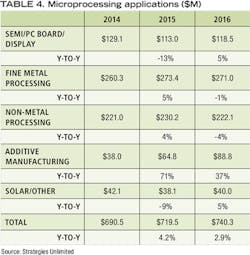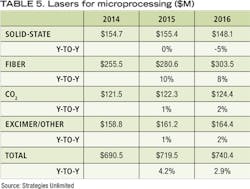Fiber laser sales continue to drive growth
A year ago, the global manufacturing market appeared to be entering an unstable period. Twelve months later, with the 2015 revenue numbers in, the international economic picture has not improved, and in fact has become more unstable. Conditions in the leading market economies have deteriorated in the past months as highly publicized events in China, Southeast Asia, Europe, and the Middle East have slowed demand, leading to reduced consumer interest in non-essential goods. And US manufacturing, which had been strong while others weren't, began to feel the fallout as factory activity in late 2015 had fallen to the lowest level since the Great Recession and exports to the aforementioned areas decreased. And to top it off, the expected surge in the economies of the emerging nations that were expected to boost their gross national products (GNPs) to lead to fresh new markets did not occur. For example, Brazil—a key component of the BRIC bloc—added to the drag on global manufacturing growth prospects as this country sank into deep recession at the end of the third quarter of 2015.
This year's analysis of the global market was put together in a less-than-exuberant atmosphere, where the impact global hotspots were having on manufacturing was clouding GDP growth prospects in many countries. Economic slowdown in Asia, led by confusing market conditions in China and Japan (with the latter now in its second recession since the election of a pro-business prime minister), quenched growth in Asia, the world's largest market. In Europe, economic good news starting the second half after months of troubling news (the scandal at VW, the world's leading auto company) seemed to be stabilizing the economies, but terrorist attacks and Syrian war refugee ingress then shook Western Europe, leading to concerns that escalation would quench any growth in the Eurozone economies.
In this rather-tempered global manufacturing environment, total industrial laser revenues ran counter to the downward trend, exhibiting quarter after quarter of mid-to-high single-digit growth. The question being asked is whether or not the laser industry is out of sync with global manufacturing-after all, there is only one company turning in strong double-digit growth quarter to quarter: IPG Photonics. Among the others showing modest growth in 2015 are suppliers of fiber lasers and those selling ultrafast lasers. The upbeat results in 2015 were led by positive financial news from the leading makers of these products.
Setting the tone was TRUMPF, the largest industrial laser/system supplier whose Laser Technology group turned in a sterling 16.8% growth to €890 million ($946 million) in its 2014/2015 fiscal year, with the company as a whole expecting single-digit growth for the 2015/2016 period. Challenging TRUMPF for market leadership is IPG Photonics, the world's leading fiber laser manufacturer, who reported an outstanding 22% growth in the third quarter and predicted seasonally adjusted fourth-quarter sales growth that would take the company close to the $1 billion revenue level. Following this are Coherent ($802 million, up 1%) and Rofin-Sinar Technologies ($520 million, down 2%). This performance for industrial lasers in an otherwise-challenged manufacturing sector comes with a slight tarnish when the numbers in TABLE 1 are reviewed. If it hadn't been for the strong double-digit growth of fiber laser revenues, the total industrial laser market would have barely shown any growth.
In 2014, fiber lasers approached the 50% level of the total industrial laser market and in 2015 surpassed it (54%). As will be seen in subsequent tables, fiber laser is the dominant (>50%) laser technology for all industrial applications. The impact of this is that the other leading laser types have lost market share—carbon-dioxide (CO2) lasers are down -5% and solid-state lasers are flat. If you needed confirmation of their decline, you could find it at the major manufacturing tradeshow Fabtech 2015, where high-power lasers were center stage in the metal fabricating hall. On display were more than 20 flat-sheet cutting system suppliers, and in 2015 all were running high-power fiber lasers with output powers ranging from 1.0 to 12.0kW. In 2014, 75% of these companies powered their systems with fiber lasers. The 2015 increase in fiber-powered laser cutters at the 2015 show closely matches the 22% gain in high-power fiber sales.
Overall in TABLE 1, industrial lasers gained 6.9% over 2014 revenues, slightly ahead of the 5% ILS forecasted at the start of 2015, with the gain coming primarily from strong fiber laser sales. Revenues for solid-state lasers would have shown a larger decrease except that high-power disk lasers offset most of this. And CO2 lasers, feeling the competition from fiber lasers, showed the largest decline. The following tables will break out the details of the markets for industrial laser material processing. Other laser types—diode and excimer—eked out a small 4% gain.
In TABLE 2, the dominance of macromaterial processing is apparent, with 59% of the total revenues attributed to lasers used to process materials in the >1kW average power range. And this application sector continues to grow annually at a strong, single-digit (9%) rate. Micromaterial processing (23% of the total revenues), which pertains to applications using <1kW laser power, continued to expand at a modest 4% rate. And the marking/engraving sector (18% of the total), the only "consumer product" in the industrial laser marketplace, continues as a reliable, if unspectacular (4%), constant growth revenue generator. The three processing categories all showed positive growth in 2015. It appears from industry forecasts that 2016 may be repeat of 2015 based on projections for a moderate first half followed by a stronger second half.
Marking/engraving holds firm
For years, the marking/engraving category (TABLE 3) had been rock-solid, with double-digit growth rates assured by industry and government regulations for serialization, coding, and marking for traceability. After a tail-off in the 2008-2009 recession, this sector dropped below a double-digit percent of total laser revenues. Then, growth recovered to a single-digit level, with growth led by new applications in egg and produce marking, replacing ink-jet in the former and gummed labels in the latter. With the growth in 2D barcodes for manufactured part marking—which in some industry sectors like auto and aircraft is mandatory—laser coding revenues have grown quickly because of marking flexibility. Exciting opportunities are now being offered in color marking stainless steel and titanium alloys, replacing manual ink processes with permanent legible marks that can be read from distances.
Of all industrial laser applications, marking/engraving equipment can be classified as a commodity product akin to laser printers, which are sold by more than 230 suppliers of systems worldwide. They all use the same laser types—primarily low-power fiber lasers and some diode-pumped solid-state (DPSS), CO2, and direct-diode lasers—all of which are locked into a buyers' market where laser profits are razor-thin and revenues increase a function of volume quantity sales.
Product suppliers have their eyes on marking with ultraviolet (UV) lasers, which produce permanent, non-interfering marks on product packaging materials that resist ink-jet marking processes and ultrafast laser marking inside transparent medical devices.
Solid growth in micromaterial processing
As shown in TABLE 4, applications on a microscale (typically <0.01 in.) processed by all types of industrial lasers experienced 4.2% growth in 2015, as a cyclical downturn in the semiconductor industry was the main cause of the ILS target of 8% growth to be missed.
This year, a newly added category—non-metal processing—includes processing materials with wavelength compatibility, such as fabrics, plastics (cutting and welding), acrylics, glass, sapphire, certain composites, and the very active field of micro-via drilling. Following the current trend of fiber laser penetration into materials processing, that technology (TABLE 5) experienced a significant 10% growth in 2015 revenues. This resulted in the micromaterial sector gaining 4.2% in revenues over 2014 in spite of a less-than-bright result from solid-state lasers at 0% growth, CO2 lasers at 1%, and other types at 1%.
The micromaterial segment of industrial laser material processing mainly uses pulsed and continuous-wave (CW) solid state, CO2, fiber, and some excimer and diode lasers. Most of these lasers produce average output power in the 50–100W range. Although in high applications, they can be rated at higher power levels to attain throughput requirements. Within the solid-state category are low-power disk lasers and ultrafast lasers that produce megawatts of peak power.
Macromaterial processing dominates revenues
In 2015, almost 60% of all revenues were generated by industrial lasers with output powers in excess of 1kW (average power). Revenues in this sector are led by metal cutting and, specifically, sheet metal cutting in the fabricated metal products industry. It is estimated that more than $1.3 billion of high-power lasers were integrated into metal cutting systems installed globally in 2015. Since fabricated metal products are a basic industry in any developed or developing country, annual growth is a function of those countries' growth in GNP—therefore, the single-digit revenue values in TABLE 6 shows estimates based on global economy projections. Manufacturing output grows about 7% in developed nations and 3% in emerging nations. Traditionally, the fabricated metal products industry has grown in the mid-to-high single digits, and laser metal cutting has followed this trend.
Laser welding has experienced a dramatic increase as the global auto industry enjoyed a resurgence of sales in early 2015 in spite of slowdowns in China, Russia, South America, and Southeast Asia. Continued hot markets for small SUVs and light trucks in North America and rebounds in auto sales in Europe also helped. As a consequence, laser welding/brazing sales picked up as automakers opted for high-strength steels that are only laser-weldable and body joint designs that require high appearance values. This shows in the 17% gain that lasers made in the welding category (TABLE 6). The forecast for 2016 is not as bright, as the impact of decreasing sales by Volkswagen (VW; the auto industry's first-half 2015 leader) that resulted from a diesel engine emission scandal may crimp growth numbers to a low single-digit.
Double-digit revenue growth in the Other category come from surface treatment applications; that is, heat treating and cladding processes and the expanded use of high-power CO2 lasers for cutting thick carbon fiber-reinforced polymer (CFRP) components.
High-power fiber lasers show a 22% increase as they penetrated further into markets long held by high-power CO2. In fact, 2014 may have been the high water mark for CO2 in this category, as new 8kW fiber lasers invaded CO2 lasers' last toe hold in the market. Growth numbers show this result, with fiber at 22% and CO2 at -7%. In the metal cutting field, fiber laser cutting has matched all the attributes of CO2 laser cutting with the added benefits of electrical efficiency, compactness, ease of maintenance, reduced operating cost, and extended maintenance periods, topped off by a competitive selling price. At the end of 2015, fiber lasers are estimated to have risen to 60% or more of laser metal cutter sales.
CO2 lasers retained a place in thick metal joining, where for example raw power is the key to single-pass autogenous butt welding of metal plate in excess of 1.0in. Also, these lasers—with output power in the kilowatt range—are ideal for cutting non-metals such as composites and acrylics. Solid-state lasers would have experienced a greater revenue decrease, were it not for the strength of the high-power disk lasers offered by TRUMPF, which are highly regarded in the automotive industry for cutting and welding applications. High-power (>1kW) diode lasers have established a niche in brazing and certain conduction welding processes, specifically in the automotive industry, where they offer high electrical efficiency, compactness, and compatibility with many of the materials used in production operations. High-brightness, high-power direct diodes with output power in excess of 2kW were introduced at international tradeshows in 2015, where at least two system integrators—Mazak Optonics and Panasonic Factory Solutions—showed kilowatt direct diodes supplied by TeraDiode for cutting and welding applications. This laser type, as an alternative to fiber lasers at the same power levels, is expected to gain some credibility in the sheet metal cutting sector in 2016.
The future
Even though ILS has been bombarded by less-than-positive news from the international manufacturing community, we continued to receive positive news from the global industrial laser community. We chalked some of this up to enthusiasm promulgated from the fiber laser industry, which is clearly on a winning streak with industry leader IPG Photonics racking up growth in the 20s. Most of the other suppliers were also reporting growth in 2015, except it was more modest. And again, countering all we heard from the global manufacturing industry, the industrial laser business for 2016 looks to match 2015 numbers. How do we rationalize this dichotomy?
Colleagues at Laser Focus World and Strategies Unlimited were also grappling with the seemingly out-of-sync industrial laser optimism. So, we lifted a comment from the LFW January issue report: "... the global success of fiber lasers and 3D printing systems are by no means anomalies. They are simply two examples among many more of winning laser technologies that should be able to beat the pack in any economic environment by improving ROI and manufacturing efficiencies for industrialized and emerging economies alike."
With our focus on industrial laser materials processing, ILS concurs because many of the applications being satisfied by laser processing are in a select group of industries that, in spite of world economic conditions, maintain substantial backlogs well into the future that enables them to continue investment in technology to enhance their position in the competitive global market.
TABLE 8 is an summary of opportunities for industrial laser processing that ILS updates periodically. This chart summarizes the global markets of opportunity for industrial lasers based on published reports on the sales and order backlogs of key industries that have a global presence. The table was updated for this report and takes into account the aforementioned economic travails around the world. A simple analysis is to look for all the red and pink and concentrate marketing efforts there, while keeping an eye on the green. Thus, North America and Asia (Japan, China, Southeast Asia, and India) are active manufacturing markets and in these regions, energy, transportation, aerospace, and fabricated metal components are hot or at least warm industries.
Referring back to TABLE 1, industrial laser system suppliers had for the most part sufficient backlog in hand and high-probability order prospects to sustain business at levels comparable to 2015. This is a pattern very similar to that of January 2015. Beyond the first half of 2016 is another matter and cautious optimism leads ILS to expect a repeat of revenues in the second half of 2015, which will produce a slightly lower growth rate (4.4%) for 2016.
Offsetting continued decreases in CO2 and solid-state revenues will be strong growth in fiber sales, supported by increases in diode and excimer sales.
As of this report, world situations remain stable, so 2016 should be a repeat of 2015 for industrial lasers.
Methodology
The methodology uses a bottom-up, demand-based process for each segment followed by a top-down approach. Then, the numbers are compared to previous forecasts.
The information, other than the forecasts, comes from both public sources and private briefings held with those in the industrial laser business. Information gained from briefings typically isn't sourced, and the author of this report ultimately remains responsible for its content.
We gathered information from a wide variety of sources, including:
• Interviews with end users, product vendors, component and module suppliers, suppliers of subcomponents, and independent industry experts;
• Press releases, sales literature, filings with the Securities and Exchange Commission (SEC) and other government agencies, and other public information;
• Statistics gathered by trade associations and research firms that follow specific markets, with our own interpretation as necessary; and
• Information gathered from PennWell resources—Strategies Unlimited, Laser Focus World, the Lasers & Photonics Marketplace Seminar, and Industrial Laser Solutions.
A point of clarification
In the tables in this report, 2014 revenue numbers have been adjusted compared to those that Industrial Laser Solutions published in January 2015. Our partner Strategies Unlimited, which collects and shares this data with ILS, made category changes for 2015 that reflect evolution in the technology. For example, a new category called Non-Metal Processing has been added to TABLE 4. Also note that high-power disk laser revenues are counted in the solid-state category.







